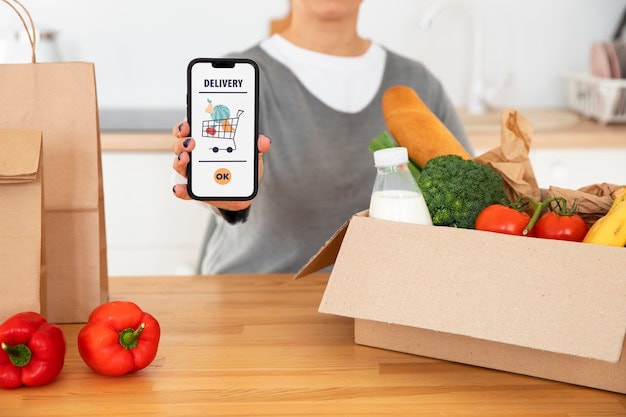The lawn and garden equipment market is experiencing a real boom. The COVID-19 pandemic has changed priorities for millions of people. Families have ...
What Is Food Delivery Software?
Written by: Howard Tillerman
Howard Tillerman is the Chief Marketing Officer for Step By Step Business and an award-winning marketing professional.
Published on September 25, 2025

The modern restaurant is a juggling act where orders come in via phones, websites, kiosks, and a half dozen third-party apps and drivers, and kitchen staff are racing the clock. There is food delivery software to create sanity in that daily storm. So what is it, how does it work, and how can it benefit small businesses in competing with the big chains? Take a coffee, and we will simplify it in simple English.
A Working Definition
Food delivery software is a combination of cloud-based software that captures, manages, and executes off-premise orders. Consider it the digital nerve center that links your menu, customers, kitchen staff, and drivers in real time. An order can be placed on your site, a delivery marketplace, or a voice assistant, but the platform will funnel all into a single dashboard and coordinate every action until the food is delivered to the doorstep.
It is sold by different vendors under different names: restaurant delivery computer software, on demand food delivery software, food delivery dispatch software, and even restaurant delivery software, all of them with the same target in mind: to make the delivery faster and without errors, and to make guests happier.
Core Components That Matter
While every platform has its quirks, most full-featured systems are built around five core modules. Understanding these will help you spot missing pieces before signing a contract.
Order Aggregation Engine
If you partner with Delivety, DoorDash, and Grubhub, plus your website, you know the pain of juggling four tablets. An aggregation engine pulls incoming orders from multiple channels into a single queue. That means fewer missed tickets, fewer transcription errors, and one clean data stream for kitchen printers or KDS screens.
Food Delivery Dispatch Software and Route Optimization
After the meal is fired, then you must determine who takes it and how they are to get there. Integrated food delivery dispatch software is used to assign orders to the correct driver, based on proximity, vehicle type, capacity, or even past on-time performance. The majority of systems include real-time GPS tracking and route optimization based on traffic, weather, and multiple drop-offs, making the wild west of driver self-selection a science.
Customer Communication Hub
Customers hate the dark. Automated SMS, in-app push notifications, and track-my-order maps keep them in the loop from “order received” to “driver at your door.” Fewer “Where’s my food?” calls free up your staff and improve review scores.
Payments, Loyalty, and Upselling
Nowadays, delivery software in restaurants allows users to merge payments, tipping, and rewards. Incremental revenue with no additional work is provided by upselling pop-ups, i.e., questions like, “Add extra guac?” Granular data (average spend, item preferences, and churn risk) is applied long-term to deliver highly targeted promotions.
Analytics and Reporting
Delivery is not a logistics problem; it is a gold mine of information. Heat maps of late deliveries, cook-time variance reports, driver scorecards, and channel profitability dashboards will enable you to spot bottlenecks and adjust operations every week rather than every year.
Why Small Operators Should Care
Corporate chains invest millions in proprietary tech, but independent owners feel the cost of inefficiency more sharply. Here’s how the right platform can level the playing field:
- Cuts phone chaos. Centralized ordering slashes misheard items and long hold times, letting staff focus on cooking instead of answering calls.
- Shrinks delivery windows. Intelligent dispatch regularly trims 7–10 minutes per order. Over a weekend rush, that means an extra turn of the kitchen.
- Reduces refund bleed. Accurate tickets and live ETAs lower cold-food complaints and give you hard proof if a customer tries to “double dip.”
- Unlocks smart marketing. Owning your order data rather than renting it from marketplaces lets you remarket to lapsed diners at almost zero cost.
- Makes staffing predictable. Historical demand curves guide scheduling so you avoid the dreaded “four drivers leaning on the counter” scenario.
Choosing the Right Restaurant Delivery Computer Software
Not every concept would fit every platform. A 90 percent delivery pizza shop will need tools different than a fancy pop-up that does takeout on weekends. The following six-step checklist will help you to prevent buyer’s remorse.
- Map your current pain points. Is it tablet overload, driver insanity, or third-party app thin margins? Prioritize issues so you are not paying for bells and whistles that you will never use.
- Demand open integrations. The system should not be a jerk on your POS, accounting software, and inventory management. Your data is trapped in closed ecosystems and increases switching costs in the future.
- Ask about marketplace order injection. Some vendors pull Uber Eats and DoorDash orders directly into your POS, while others require middleware. Clarify this early.
- Test the dispatch logic. Set up a sandbox account and simulate peak hours. Does the algorithm respect prep times? Can you override assignments manually?
- Validate the fee structure. SaaS pricing may range anywhere from monthly flat charges to per-order commission-based. Pretend that everything is going to be the best-case scenario and the worst-case scenario before signing.
- Check driver adoption. The smoothest dashboard is useless when your drivers despise the app. In-app navigation, batch navigation to multi-drop, and on-demand tip payouts are some of the features to look out for.
Tip: Negotiate a 60- or 90-day exit clause. If promised efficiencies don’t materialize, you need an escape hatch.
The Bottom Line
Food delivery software is not an option anymore for the restaurants that are planning to succeed in the on-demand economy. The correct platform can turn delivery into a solid profit driver through aggregation of orders, automation of dispatch, and the presentation of actionable information. To the small business owner and aspiring restaurateur, the decision to embrace purpose-built restaurant delivery software is not one driven by shiny technology; it is a decision to take control over guest experience and your margins.
Begin with a sober look at where you are suffering today, pilot hard to test the solutions to address real needs, and begin. Master those steps, and you not only will serve the meals quicker but also will get more five-star reviews and grow sustainably even in a situation where your rival in the town could afford to outspend you.
Subscribe to Our Newsletter
and gain insider access to cutting-edge business insights and trends.
Featured Resources

Spare Parts vs. Big Equipment: Which Business Model Brings Higher Profit in the Home and Garden Market?
Published on December 9, 2025
Read Now

How to Prepare for Your First Business Trip
Published on December 2, 2025
Your first business trip feels exciting. It feels nerve-racking at the same time. You want to look prepared. You want to make a strong impression.Yo ...
Read Now

Unit4 Review 2025: The First ERP Built for Nonprofits, Not LLCs
Published on December 2, 2025
Every year, millions of Americans take the leap into entrepreneurship. In fact, no less than 5.5 million new business applications were filed in the ...
Read Now
Comments